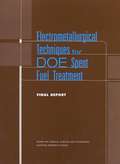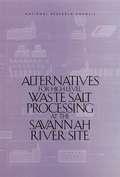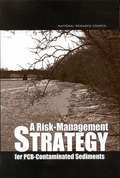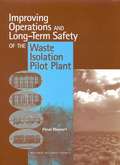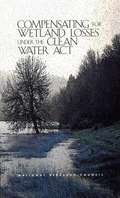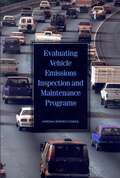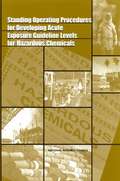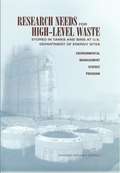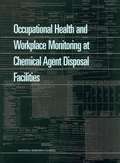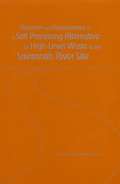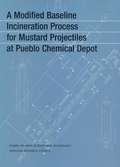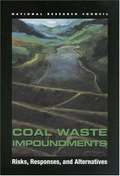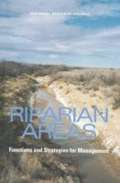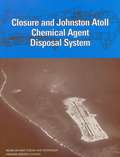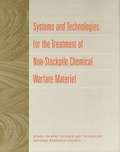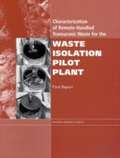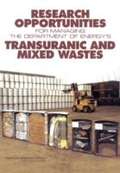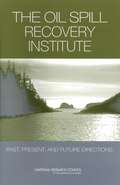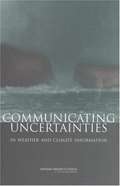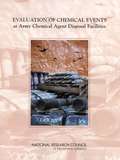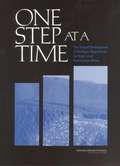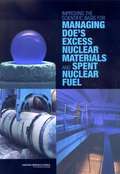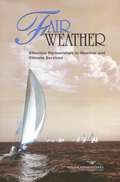- Table View
- List View
Electrometallurgical Techniques for DOE Spent Fuel Treatment: FINAL REPORT
by Committee on Electrometallurgical Techniques for DOE Spent Fuel TreatmentThe National Academies Press (NAP)--publisher for the National Academies--publishes more than 200 books a year offering the most authoritative views, definitive information, and groundbreaking recommendations on a wide range of topics in science, engineering, and health. Our books are unique in that they are authored by the nation's leading experts in every scientific field.
Alternatives For High-level Waste Salt Processing At The Savannah River Site
by National Research CouncilAt the request of the US Department of Energy, the Committee provides a technical review of alternatives selected by representatives of the South Carolina site for processing the high-level radioactive waste salt solutions stored there in 48 below-grade tanks. Annotation c. Book News, Inc. , Portland, OR (booknews. com)
Disposition of High-level Waste and Spent Nuclear Fuel: The Continuing Societal and Technical Challenges
by National Research CouncilFocused attention by world leaders is needed to address the substantial challenges posed by disposal of spent nuclear fuel from reactors and high-level radioactive waste from processing such fuel. The biggest challenges in achieving safe and secure storage and permanent waste disposal are societal, although technical challenges remain. Disposition of radioactive wastes in a deep geological repository is a sound approach as long as it progresses through a stepwise decision-making process that takes advantage of technical advances, public participation, and international cooperation. Written for concerned citizens as well as policymakers, this book was sponsored by the U.S. Department of Energy, U.S. Nuclear Regulatory Commission, and waste management organizations in eight other countries.
A Risk-Management STRATEGY for PCB-Contaminated Sediments
by Committee on Remediation of PCB-Contaminated SedimentsThe National Academies Press (NAP)--publisher for the National Academies--publishes more than 200 books a year offering the most authoritative views, definitive information, and groundbreaking recommendations on a wide range of topics in science, engineering, and health. Our books are unique in that they are authored by the nation's leading experts in every scientific field.
Improving Operations AND Long-Term Safety OF THE Waste Isolation Pilot Plant: Final Report
by National Research CouncilThe National Academies Press (NAP)--publisher for the National Academies--publishes more than 200 books a year offering the most authoritative views, definitive information, and groundbreaking recommendations on a wide range of topics in science, engineering, and health. Our books are unique in that they are authored by the nation's leading experts in every scientific field.
Compensating For Wetland Losses Under The Clean Water Act
by Committee on Mitigating Wetland LossesRecognizing the importance of wetland protection, the Bush administration in 1988 endorsed the goal of “no net loss” of wetlands. Specifically, it directed that filling of wetlands should be avoided, and minimized when it cannot be avoided. When filling is permitted, compensatory mitigation must be undertaken; that is, wetlands must be restored, created, enhanced, and, in exceptional cases, preserved, to replace the permitted loss of wetland area and function, such as water quality improvement within the watershed. After more than a dozen years, the national commitment to “no net loss” of wetlands has been evaluated. This new book explores the adequacy of science and technology for replacing wetland function and the effectiveness of the federal program of compensatory mitigation in accomplishing the nation’s goal of clean water. It examines the regulatory framework for permitting wetland filling and requiring mitigation, compares the mitigation institutions that are in use, and addresses the problems that agencies face in ensuring sustainability of mitigated wetlands over the long term. Gleaning lessons from the mixed results of mitigation efforts to date, the book offers 10 practical guidelines for establishing and monitoring mitigated wetlands. It also recommends that federal, state, and local agencies undertake specific institutional reforms. This book will be important to anyone seeking a comprehensive understanding of the “no net loss” issue: policy makers, regulators, environmental scientists, educators, and wetland advocates.
Evaluating Vehicle Emissions Inspection and Maintenance Programs
by Committee on Vehicle Emission Inspection Maintenance ProgramsEmissions inspection and maintenance (I/M) programs subject vehicles to periodic inspections of their emission control systems. Despite widespread use of these programs in air-quality management, policy makers and the public have found a number of problems associated with them. Prominent among these issues is the perception that emissions benefits and other impacts of I/M programs have not been evaluated adequately. Evaluating Vehicle Emissions Inspection and Maintenance Programsassesses the effectiveness of these programs for reducing mobile source emissions. In this report, the committee evaluates the differences in the characteristics of motor vehicle emissions in areas with and without I/M programs, identifies criteria and methodologies for their evaluation, and recommends improvements to the programs. Most useful of all, this book will help summarize the observed benefits of these programs and how they can be redirected in the future to increase their effectiveness.
Standing Operating Procedures for Developing Acute Exposure Guideline Levels for Hazardous Chemicals
by Subcommittee on Acute Exposure Guideline LevelsStanding Operating Procedures for Developing Acute Exposure Guideline Levels for Hazardous Chemicals contains a detailed and comprehensive methodology for developing acute exposure guideline levels (AEGLs) for toxic substances from inhalation exposures. The book provides guidance on what documents and databases to use, toxicity endpoints that need to be evaluated, dosimetry corrections from animal to human exposures, selection of appropriate uncertainty factors to address the variability between animals and humans and within the human population, selection of modifying factors to address data deficiencies, time scaling, and quantitative cancer risk assessment. It also contains an example of a summary of a technical support document and an example of AEGL derivation. This book will be useful to persons in the derivation of levels from other exposure routes—both oral and dermal—as well as risk assessors in the government, academe, and private industry.
Research Needs For High-level Waste Stored In Tanks And Bins At U.s. Department Of Energy Sites: Environmental Management Science Program
by Committee on Long-Term Research Needs for Radioactive High-level Waste at Department of Energy SitesThe committee was charged to identify high-level waste problems that cannot be addressed effectively with current technologies, and to recommend areas of research by which the Department's Science Program can make significant contributions to solving these problems and adding to scientific knowledge generally. The members were selected for their expertise in various relevant fields. The report is not indexed. Annotation c. Book News, Inc. , Portland, OR (booknews. com)
Occupational Health and Workplace Monitoring at Chemical Agent Disposal Facilities
by National Research CouncilThe National Academies Press (NAP)--publisher for the National Academies--publishes more than 200 books a year offering the most authoritative views, definitive information, and groundbreaking recommendations on a wide range of topics in science, engineering, and health. Our books are unique in that they are authored by the nation's leading experts in every scientific field.
Research and Development on a Salt Processing Alternative for High-level Waste at the Savannah River Site
by Committee on Radionuclide Separation Processes for High-level Waste at the Savannah River SiteThe National Academies Press (NAP)--publisher for the National Academies--publishes more than 200 books a year offering the most authoritative views, definitive information, and groundbreaking recommendations on a wide range of topics in science, engineering, and health. Our books are unique in that they are authored by the nation's leading experts in every scientific field.
A Modified Baseline Incineration Process For Mustard Projectiles At Pueblo Chemical Depot
by National Research CouncilThe National Academies Press (NAP)--publisher for the National Academies--publishes more than 200 books a year offering the most authoritative views, definitive information, and groundbreaking recommendations on a wide range of topics in science, engineering, and health. Our books are unique in that they are authored by the nation's leading experts in every scientific field.
COAL WASTE IMPOUNDMENTS: Risks, Responses, and Alternatives
by Committee on Coal Waste ImpoundmentsOn October 11, 2000, a breakthrough of Martin County Coal Corporation’s coal waste impoundment released 250 million gallons of slurry in near Inez, Kentucky. The 72-acre surface impoundment for coal processing waste materials broke through into a nearby underground coal mine. Although the spill caused no loss of human life, environmental damage was significant, and local water supplies were disrupted. This incident prompted Congress to request the National Research Council to examine ways to reduce the potential for similar accidents in the future. This book covers the engineering practices and standards for coal waste impoundments and ways to evaluate, improve, and monitor them; the accuracy of mine maps and ways to improve surveying and mapping of mines; and alternative technologies for coal slurry disposal and utilization. The book contains advice for multiple audiences, including the Mine Safety and Health Administration, the Office of Surface Mining, and other federal agencies; state and local policymakers and regulators; the coal industry and its consultants; and scientists and engineers.
Riparian Areas: Functions and Strategies for Management
by Committee on Riparian Zone Functioning Strategies For ManagementThe Clean Water Act (CWA) requires that wetlands be protected from degradation because of their important ecological functions including maintenance of high water quality and provision of fish and wildlife habitat. However, this protection generally does not encompass riparian areas--the lands bordering rivers and lakes--even though they often provide the same functions as wetlands. Growing recognition of the similarities in wetland and riparian area functioning and the differences in their legal protection led the NRC in 1999 to undertake a study of riparian "areas, which has culminated in Riparian Areas: Functions and Strategies for Management. The report is intended to heighten awareness of riparian areas commensurate with their ecological and societal values. The primary conclusion is that, because riparian areas perform a disproportionate number of biological and physical functions on a unit area basis, restoration of riparian functions along America's waterbodies should be a national goal.
Closure And Johnston Atoll Chemical Agent Disposal System
by Committee on Review Evaluation of the Army Chemical Stockpile Disposal ProgramJohnston Atoll Chemical Agent Disposal System (JACADS), the first fully integrated chemical agent disposal facility, is located on Johnston Island some 800 miles southwest of Hawaii. JACADS completed ten years of operations in November 2000, which resulted in the disposal of more than 2000 tons of nerve and mustard agents. In 1998, the Army began planning for closure and dismantling of the facility. In 1999, the NRC was asked to review the Army's planning. This book presents an assessment of planned and ongoing closure activities on Johnston Island in some detail. It also provides an analysis of the likely implications for closure of disposal facilities at eight continental U. S. storage sites.
Systems and Technologies for the Treatment of Non-Stockpile Chemical Warfare Materiel
by National Research CouncilThe main approach adopted by the U. S. Army for destruction of all declared chemical weapon materiel (CWM) is incineration. There has been considerable public opposition to this approach, however, and the Army is developing a mix of fixed site and mobile treatment technologies to dispose of non-stockpile CWM. To assist in this effort, the Army requested NRC to review and evaluate these technologies, and to assess its plans for obtaining regulatory approval for and to involve the public in decisions about the application of those technologies. This book presents an assessment of non-stockpile treatment options and the application of these systems to the non-stockpile inventory, of regulatory and permitting issues, and of the role of the public.
National Capacity in Forestry Research
by Committee on National Capacity in Forestry ResearchThe National Academies Press (NAP)--publisher for the National Academies--publishes more than 200 books a year offering the most authoritative views, definitive information, and groundbreaking recommendations on a wide range of topics in science, engineering, and health. Our books are unique in that they are authored by the nation's leading experts in every scientific field.
Characterization Of Remote-handled Transuranic Waste For The Waste Isolation Pilot Plant: Final Report
by Committee on the Characterization of Remote-Handled Transuranic Waste for the Waste Isolation Pilot PlantThe U.S. Department of Energy (DOE) disposes of plutonium-contaminated debris from its 27 nuclear weapons facilities at the Waste Isolation Pilot Plant (WIPP), an underground repository in Carlsbad, New Mexico. After four years of operational experience, DOE has opportunities to make changes to the costly and time-consuming process of "characterizing" the waste to confirm that it is appropriate for shipment to and disposal at WIPP. The report says that in order to make such changes, DOE should conduct and publish a systematic and quantitative assessment to show that the proposed changes would not affect the protection of workers, the public, or the environment.
Research Opportunities For Managing The Department Of Energy's Transuranic And Mixed Wastes
by Committee on Long-Term Research Needs for Managing Transuranic Mixed Wastes at Department of Energy SitesAbout 155,000 cubic meters of waste contaminated with both radioactive isotopes and hazardous chemicals are stored at some 30 DOE sites, and another 450,000 cubic meters are buried. While DOE is making a concerted effort to properly dispose of this waste, the amount translates to a multi-decade effort that will require handling, characterizing, and shipping hundreds of thousands of waste containers at a total cost of billions of dollars. This report describes basic scientific research that can lead to new technologies for performing these tasks more safely and cost effectively.
The Oil Spill Recovery Institute: Past, Present, And Future Directions
by Committee to Review the Oil Spill Recovery Institute's Research ProgramAs a result of the 1989 Exxon Valdez Oil Spill in Prince William Sound, Congress passed the Oil Pollution Act of 1990 (OPA 90), and within that legislation, the Oil Spill Recovery Institute (OSRI) was born. This book assesses the strength and weaknesses of this research program, with empahsis on whether the activities supported to date address the OSRI mission, whether the processes used are sound, and whether the research and technology development projects are of high quality.
A Workshop Summary Communicating Uncertainties in Weather and Climate Information
by Elbert W. FridayThe report explores how best to communicate weather and climate information by presenting five case studies, selected to illustrate a range of time scales and issues, from the forecasting of weather events, to providing seasonal outlooks, to projecting climate change.
EVALUATION OF CHEMICAL EVENTS at Army Chemical Agent Disposal Facilities
by Committee on Evaluation of Chemical Events at Army Chemical Agent Disposal FacilitiesFor over a decade the Army has been carrying out a program aimed at the destruction of accumulated chemical weapons stored at several sites. While destruction by incineration has been successful, several incidents -- called chemical events -- occurred during the disposal process or decontamination activities that raised some public concerns about the safety of operations of three third generation incineration facilities. As a result, the Congress asked the NRC to investigate whether the incidents provide information useful to help ensure safe operation of the future sites. This book presents an analysis of causes of and responses to past chemical events, implications of such events for ongoing and future demilitarization activities, and recommendations for preparing for future events.
One Step at a Time: The Staged Development of Geologic Repositories for High-Level Radioactive Waste
by Committee on Principles Operational Strategies for Staged Repository SystemsCompared to other large engineering projects, geologic repositories for high-level waste present distinctive challenges because: 1) they are first-of-a-kind, complex, and long-term projects that must actively manage hazardous materials for many decades: 2) they are expected to hold these hazardous materials passively safe for many millennia after repository closure; and 3) they are widely perceived to pose serious risks. As is the case for other complex projects, repository programs should proceed in stages. One Step at a Time focuses on a management approach called "adaptive staging" as a promising means to develop geologic repositories for high-level radioactive waste such as the proposed repository at Yucca Mountain, Nevada. Adaptive staging is a learn-as-you-go process that enables project managers to continuously reevaluate and adjust the program in response to new knowledge and stakeholder input. Advice is given on how to implement staging during the construction, operation, closure, and post-closure phases of a repository program.
Improving The Scientific Basis For Managing Doe's Excess Nuclear Materials And Spent Nuclear Fuel
by Committee on Improving the Scientific Basis for Managing Nuclear Materials Spent Nuclear Fuel through the Environmental Management Science ProgramThis study identifies research opportunities for storage, recycle, reuse, or disposal of nuclear materials and spent nuclear fuel. Most of the materials dealt with in this report have not been declared as waste. The report completes the fifth in a series of studies requested by the EMSP to assist in developing its calls for proposals and evaluating proposals on this issue. There is no subject index. Annotation ©2004 Book News, Inc. , Portland, OR (booknews. com)
Fair Weather: Effective Partnership in Weather and Climate Services
by Committee on Partnerships in WeatherDecades of evolving U.S. policy have led to three sectors providing weather services--NOAA (primarily the National Weather Service [NWS]), academic institutions, and private companies. This three-sector system has produced a scope and diversity of weather services in the United States second to none. However, rapid scientific and technological change is changing the capabilities of the sectors and creating occasional friction. Fair Weather: Effective Partnerships in Weather and Climate Services examines the roles of the three sectors in providing weather and climate services, the barriers to interaction among the sectors, and the impact of scientific and technological advances on the weather enterprise. Readers from all three sectors will be interested in the analysis and recommendations provided in Fair Weather.
